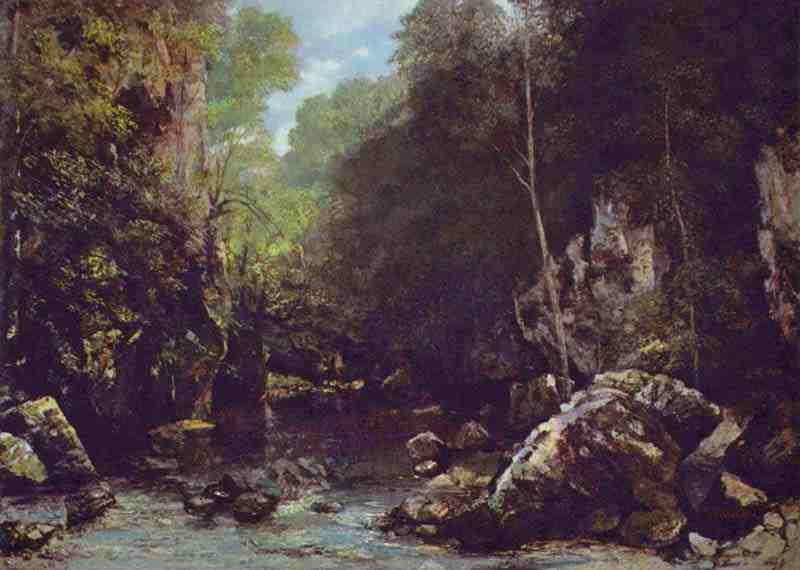
Rocky river valley. Gustave Courbet
1865, oil on canvas, 94 × 135 cm
Paris, Musée d'Orsay
---
Felsiges Flußtal. Gustave Courbet
1865, Öl auf Leinwand, 94 × 135 cm
Paris, Musée d'Orsay
---
----
Fine Art Prints | Greeting Cards | Phone Cases | Lifestyle | Face Masks | Men's , Women' Apparel | Home Decor | jigsaw puzzles | Notebooks | Tapestries | ...
----
Le ruisseau noir (The Black Stream) (also known in En. as Stream in a Ravine) is an oil-on-canvas landscape painted by French artist Gustave Courbet in 1865. It is currently held and exhibited at the Musée d'Orsay in Paris.
History
This picture was included in the Exposition Universelle of 1867, and was bought from the artist in the same year by the Comte de Nieuwerkerque, Director of Museums, for Napoleon III, at the price of 2000 French francs. It was part of the Emperor's personal property, and was allotted to the Louvre by the Tribunal de la Seine, along with other paintings, on 12 February 1879. In 1881, it was exhibited in the Luxembourg, with the title Le puits noir (The Black Ravine), which is really the name of another work painted in 1869.[1]
The landscape is currently housed and exhibited at the Musée d'Orsay in Paris, and represents a gorge, a ravine through which runs a winding stream, its bed littered with rocks, between steep walls covered with wild vegetation. The stream depicted is the Loue, a capricious creek flowing through the village of Ornans, where Courbet was born. The artist seems to have returned to this spot several times: it can be recognised in a number of his paintings[2]
Of this landscape, Courbet wrote:
It is perhaps the best I have ever painted; it shows the Loue walled up between vast boulders of mossy rock, with thick sunlit foliage in the background.[3]
Courbet loved to seek out some unspoilt corner in these lonely gorges, where the damp atmosphere conveys the impression of a strange world from which the primordial waters have only just receded. In this work, in which one senses the enthusiasm of the artist, Courbet's technique is at its peak of perfection. He has only used the brush in the background shadows; elsewhere the painting has been done with the palette knife. Courbet crushes his pigments and spreads them diagonally with his knife, thus letting underlying wads of paint show through: this creates the effect of transparency and depth as rich as those obtained by means of glazes in the work of earlier artists. His splendid greens evoke the luxuriance of a semi-aquatic world where vegetation runs riot.[4]
Notes
Public Domain This article incorporates text from a publication now in the public domain: Chisholm, Hugh, ed. (1911). Encyclopædia Britannica (11th ed.). Cambridge University Press. - See also Le puits noir, 1869.
Acquired by the Louvre in 1950 and now at the Musée des Beaux-Arts et d'archéologie de Besançon. Another of these landscape works, somewhat smaller than the present painting, exactly resembles it as far as the details of execution are concerned. It is dated 1866 and is in the Museum of Montpellier and is entitled Solitude.
G. Courbet, Letters of Gustave Courbet, University of Chicago Press (1992).
See J. Lindsay, Gustave Courbet his life and art, Jupiter Books (1977); F. Masanès, Gustave Courbet: Unsentimental Realism, Taschen (2006).
References
Monographs on the art and life of Courbet have been written by Estignard (Paris, 1874), D'Ideville, (Paris, 1878), Silvestre in Les artistes français, (Paris, 1878), Isham in Van Dyke's Modern French Masters (New York, 1896), Meier-Graefe, Corot and Courbet, (Leipzig, 1905), Cazier (Paris, 1906), Riat, (Paris, 1906), Muther, (Berlin, 1906), Robin, (Paris, 1909), Benedite, (Paris, 1911) and Lazár Béla (Paris, 1911) (French). Consult also Muther History of Modern Painting, volume ii (London, 1896, 1907); Patoux, "Courbet" in Les artistes célèbres and La vérité sur Courbet (Paris, 1879) (French); Le Men, Courbet (New York, 2008).
Lindsay, Jack. Gustave Courbet his life and art. Publ. Jupiter Books (London) Limited 1977.
Lemonnier, C, Les Peintres de la Vie (Paris, 1888).(French)
Mantz, "G. Courbet," Gaz. des beaux-arts (Paris, 1878).(French)
Masanès, Fabrice, Gustave Courbet: Unsentimental Realism (Cologne: Taschen, 2006)
Nochlin, Linda, Courbet, (London: Thames & Hudson, 2007)
Nochlin, Linda, Realism: Style and Civilization (New York: Penguin, 1972)
See also
Gustave Courbet
History of painting
Western painting
Musée d'Orsay
External links
Wikimedia Commons has media related to:
Gustave Courbet (category)
Le ruisseau noir at the Musée d'Orsay
Gallery of paintings by Gustave Courbet
Art Renewal Center; biography and images
Retrieved from "http://en.wikipedia.org/"
All text is available under the terms of the GNU Free Documentation License


